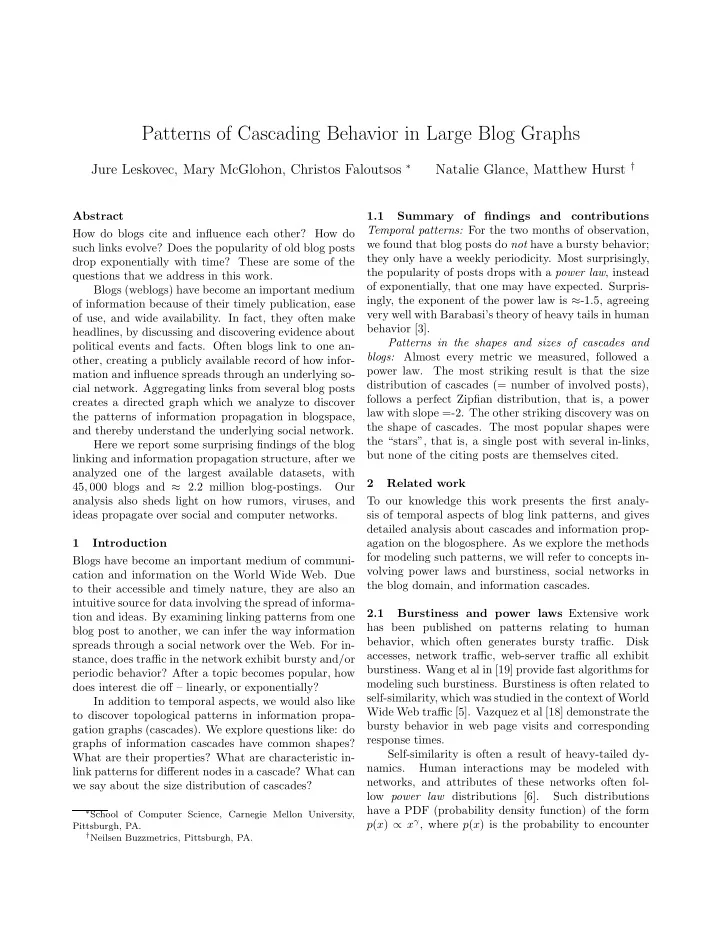

Patterns of Cascading Behavior in Large Blog Graphs Jure Leskovec, Mary McGlohon, Christos Faloutsos ∗ Natalie Glance, Matthew Hurst † Abstract 1.1 Summary of findings and contributions Temporal patterns: For the two months of observation, How do blogs cite and influence each other? How do we found that blog posts do not have a bursty behavior; such links evolve? Does the popularity of old blog posts they only have a weekly periodicity. Most surprisingly, drop exponentially with time? These are some of the the popularity of posts drops with a power law , instead questions that we address in this work. of exponentially, that one may have expected. Surpris- Blogs (weblogs) have become an important medium ingly, the exponent of the power law is ≈ -1.5, agreeing of information because of their timely publication, ease very well with Barabasi’s theory of heavy tails in human of use, and wide availability. In fact, they often make behavior [3]. headlines, by discussing and discovering evidence about Patterns in the shapes and sizes of cascades and political events and facts. Often blogs link to one an- Almost every metric we measured, followed a blogs: other, creating a publicly available record of how infor- power law. The most striking result is that the size mation and influence spreads through an underlying so- distribution of cascades (= number of involved posts), cial network. Aggregating links from several blog posts follows a perfect Zipfian distribution, that is, a power creates a directed graph which we analyze to discover law with slope =-2. The other striking discovery was on the patterns of information propagation in blogspace, the shape of cascades. The most popular shapes were and thereby understand the underlying social network. the “stars”, that is, a single post with several in-links, Here we report some surprising findings of the blog but none of the citing posts are themselves cited. linking and information propagation structure, after we analyzed one of the largest available datasets, with 2 Related work 45 , 000 blogs and ≈ 2 . 2 million blog-postings. Our analysis also sheds light on how rumors, viruses, and To our knowledge this work presents the first analy- ideas propagate over social and computer networks. sis of temporal aspects of blog link patterns, and gives detailed analysis about cascades and information prop- 1 Introduction agation on the blogosphere. As we explore the methods for modeling such patterns, we will refer to concepts in- Blogs have become an important medium of communi- volving power laws and burstiness, social networks in cation and information on the World Wide Web. Due the blog domain, and information cascades. to their accessible and timely nature, they are also an intuitive source for data involving the spread of informa- 2.1 Burstiness and power laws Extensive work tion and ideas. By examining linking patterns from one has been published on patterns relating to human blog post to another, we can infer the way information behavior, which often generates bursty traffic. Disk spreads through a social network over the Web. For in- accesses, network traffic, web-server traffic all exhibit stance, does traffic in the network exhibit bursty and/or burstiness. Wang et al in [19] provide fast algorithms for periodic behavior? After a topic becomes popular, how modeling such burstiness. Burstiness is often related to does interest die off – linearly, or exponentially? self-similarity, which was studied in the context of World In addition to temporal aspects, we would also like Wide Web traffic [5]. Vazquez et al [18] demonstrate the to discover topological patterns in information propa- bursty behavior in web page visits and corresponding gation graphs (cascades). We explore questions like: do response times. graphs of information cascades have common shapes? Self-similarity is often a result of heavy-tailed dy- What are their properties? What are characteristic in- namics. Human interactions may be modeled with link patterns for different nodes in a cascade? What can networks, and attributes of these networks often fol- we say about the size distribution of cascades? low power law distributions [6]. Such distributions have a PDF (probability density function) of the form ∗ School of Computer Science, Carnegie Mellon University, p ( x ) ∝ x γ , where p ( x ) is the probability to encounter Pittsburgh, PA. † Neilsen Buzzmetrics, Pittsburgh, PA.
Recommend
More recommend